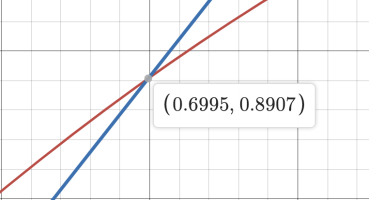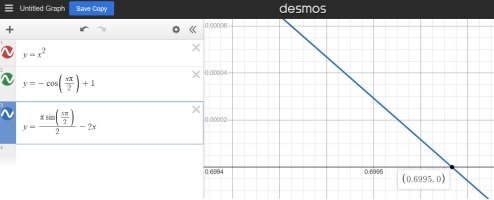You are using an out of date browser. It may not display this or other websites correctly.
You should upgrade or use an alternative browser.
You should upgrade or use an alternative browser.
solve for x
- Thread starter Perdurat
- Start date
Otis
Elite Member
- Joined
- Apr 22, 2015
- Messages
- 4,592
Hi Perdurat. I think that value of x can only be approximated. The equation equates an algebraic function with a transcendental function. (Your question is similar to asking, "What is the exact value of pi".)this resolves in a constant (0.6995<x<0.6996), is there a way to express this constant as in x = ...
There are two additional solutions, one of which is an Integer.
[imath]\;[/imath]
Well there is, but are you sure that you want to see it?[math]\sin\left(\frac{\pi x}{2}\right)=\frac{4x}{\pi}[/math]
i know this resolves in a constant (0.6995<x<0.6996), is there a way to express this constant as in x = ...
thanks for your help
[imath]\displaystyle x = \sqrt{\frac{56}{π^2} + \frac{1}{3 π^8 \left(\frac{2}{-69672960 π^{16} - 2128896 π^{18} + \sqrt{4854321355161600 π^{32} + 296652971704320 π^{34} + 11611416821760 π^{36}}}\right)^{1/3}} - 4032 π^4 \left(\frac{2}{-69672960 π^{16} - 2128896 π^{18} + \sqrt{4854321355161600 π^{32} + 296652971704320 π^{34} + 11611416821760 π^{36}}}\right)^{1/3}} \approx 0.6995[/imath]
[imath]\displaystyle x = -\sqrt{\frac{56}{π^2} + \frac{1}{3 π^8 \left(\frac{2}{-69672960 π^{16} - 2128896 π^{18} + \sqrt{4854321355161600 π^{32} + 296652971704320 π^{34} + 11611416821760 π^{36}}}\right)^{1/3}} - 4032 π^4 \left(\frac{2}{-69672960 π^{16} - 2128896 π^{18} + \sqrt{4854321355161600 π^{32} + 296652971704320 π^{34} + 11611416821760 π^{36}}}\right)^{1/3}} \approx -0.6995[/imath]
I hope that Mr.Otis is now convinced that this is my [imath]1000[/imath] complicated approximation
Note: I have put [imath]=[/imath] there in purpose.
I was playing around with a graphing calculator (desmos)I'd be surprised if there were an exact analytical expression for the solution.
Just curious: where does this problem come from?
starting off with:
[math]y=x^{2}[/math]
within the interval -1<x<+1, I tried to approximate the curve with a trigonometric function:
[math]y=-\cos\left(\frac{\pi}{2}x\right)+1[/math]
for the value x=-1, 0 and +1 both functions yield the same result (1, 0 and 1 resp.)
next I asked myselve for which value in between, the difference beween both functions would yield the biggest difference (derrivative):
[math](-\cos\left(\frac{\pi}{2}x\right)-x^{2}+1)dx/dt[/math]
this yields:
[math]\frac{\pi\sin\left(\frac{\pi x}{2}\right)}{2}-2x[/math]
since for a max and min, the derrivative yields 0 :
[math]\frac{\pi\sin\left(\frac{\pi x}{2}\right)}{2}-2x = 0[/math]
or:
[math]\sin\left(\frac{\pi x}{2}\right)=\frac{4x}{\pi}[/math]
expressing the distance of two parallel lines to the Y axis (+-X)
so now I was trying to find an expression for this value
you're out of my league, by a few lightyears or soWell there is, but are you sure that you want to see it?
[imath]\displaystyle x = \sqrt{\frac{56}{π^2} + \frac{1}{3 π^8 \left(\frac{2}{-69672960 π^{16} - 2128896 π^{18} + \sqrt{4854321355161600 π^{32} + 296652971704320 π^{34} + 11611416821760 π^{36}}}\right)^{1/3}} - 4032 π^4 \left(\frac{2}{-69672960 π^{16} - 2128896 π^{18} + \sqrt{4854321355161600 π^{32} + 296652971704320 π^{34} + 11611416821760 π^{36}}}\right)^{1/3}} \approx 0.6995[/imath]
[imath]\displaystyle x = -\sqrt{\frac{56}{π^2} + \frac{1}{3 π^8 \left(\frac{2}{-69672960 π^{16} - 2128896 π^{18} + \sqrt{4854321355161600 π^{32} + 296652971704320 π^{34} + 11611416821760 π^{36}}}\right)^{1/3}} - 4032 π^4 \left(\frac{2}{-69672960 π^{16} - 2128896 π^{18} + \sqrt{4854321355161600 π^{32} + 296652971704320 π^{34} + 11611416821760 π^{36}}}\right)^{1/3}} \approx -0.6995[/imath]
I hope that Mr.Otis is now convinced that this is my [imath]1000[/imath] complicated approximation
Note: I have put [imath]=[/imath] there in purpose.
Thanks. I hope that this will serve your purpose.you're out of my league, by a few lightyears or so
BigBeachBanana
Senior Member
- Joined
- Nov 19, 2021
- Messages
- 2,273
I don't doubt the expression evaluates to the correct answer, but many expressions result in the same numerical value. I would like to see the approximation method that arrives at that specific expression.Something tells me that @mario99 is joking. Wonder if that huge expression evaluates to close to 0.
The only way to find out is to test it!Wonder if that huge expression evaluates to close to 0.
That is beyond the scope of this thread!I don't doubt the expression evaluates to the correct answer, but many expressions result in the same numerical value. I would like to see the approximation method.
BigBeachBanana
Senior Member
- Joined
- Nov 19, 2021
- Messages
- 2,273
If you say so, but I urge the OP not to trust the result until the process is verified.That is beyond the scope of this thread!
option 1: the monster equation yields the result (+-0.6995...) (i do not understand the method)If you say so, but I urge the OP not to trust the result until the process is verified.
option 2: mario typed in the equation in desmos or the like (from which I started) (a) and then added the monster as a joke
(a) this would be indirect proof that the earth is round, untill the monster is confirmed ligid, i shall remain confident that the earth is flat
BigBeachBanana
Senior Member
- Joined
- Nov 19, 2021
- Messages
- 2,273
Legit?ligid
People who tried to prove the Earth was flat often went in circles.i shall remain confident that the earth is flat
Desmos is crazy. It gives that the two functions meet each other at [imath]x = 0.7[/imath]. I thought that he is so precise!option 1: the monster equation yields the result (+-0.6995...) (i do not understand the method)
option 2: mario typed in the equation in desmos or the like (from which I started) (a) and then added the monster as a joke
(a) this would be indirect proof that the earth is round, untill the monster is confirmed ligid, i shall remain confident that the earth is flat
BigBeachBanana
Senior Member
- Joined
- Nov 19, 2021
- Messages
- 2,273
Ahh thanks, so the trick was to zoom in!Zoom in more.
View attachment 38315
Nice one to get the point by using the derivative of each function.see attachmentView attachment 38316
anyway i calculated the monster : 2,75885829529689Nice one to get the point by using the derivative of each function.
this:
-not necessarily disproves that the earth is flat
-definitely proves your real name is not Mario Ramanujan
since a joke can only be considered to be a good joke if the laughter consumes more time than the telling,
the question remains: did I spent more time in xls calculating it, or did you spent more time in latex creating it
(for it=monster)
|
|
Then, your calculator is not a good calculator. How did you calculate it?anyway i calculated the monster : 2,75885829529689
this:
-not necessarily disproves that the earth is flat
-definitely proves your real name is not Mario Ramanujan
since a joke can only be considered to be a good joke if the laughter consumes more time than the telling,
the question remains: did I spent more time in xls calculating it, or did you spent more time in latex creating it
(for it=monster)


